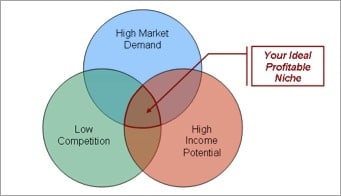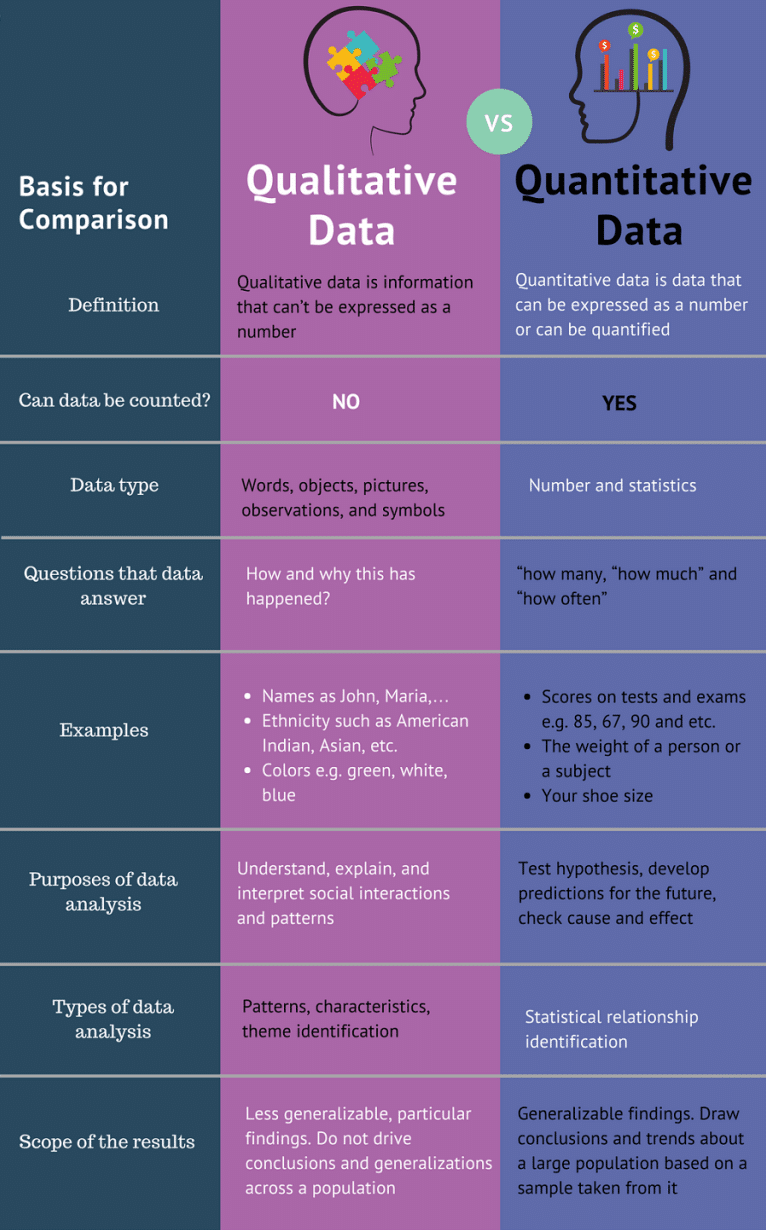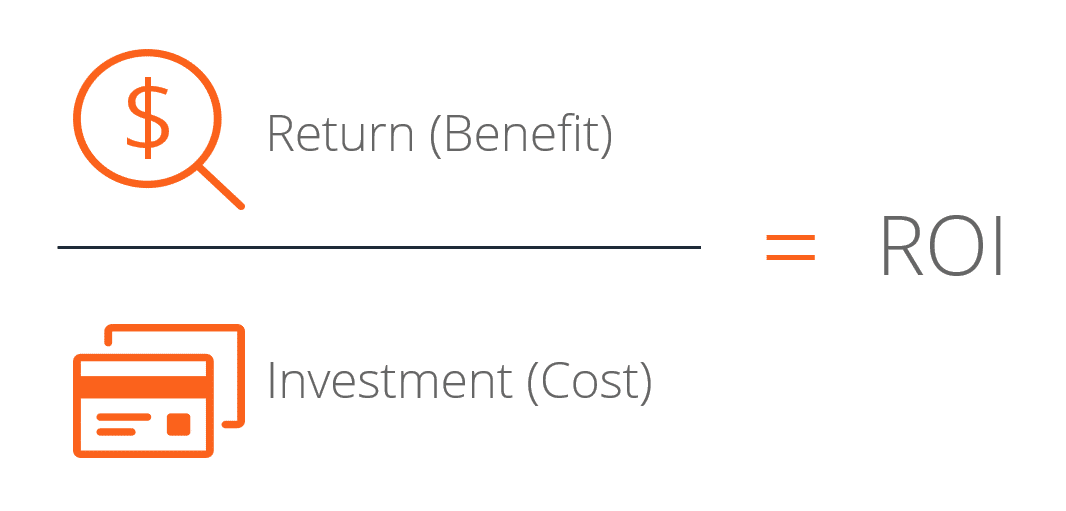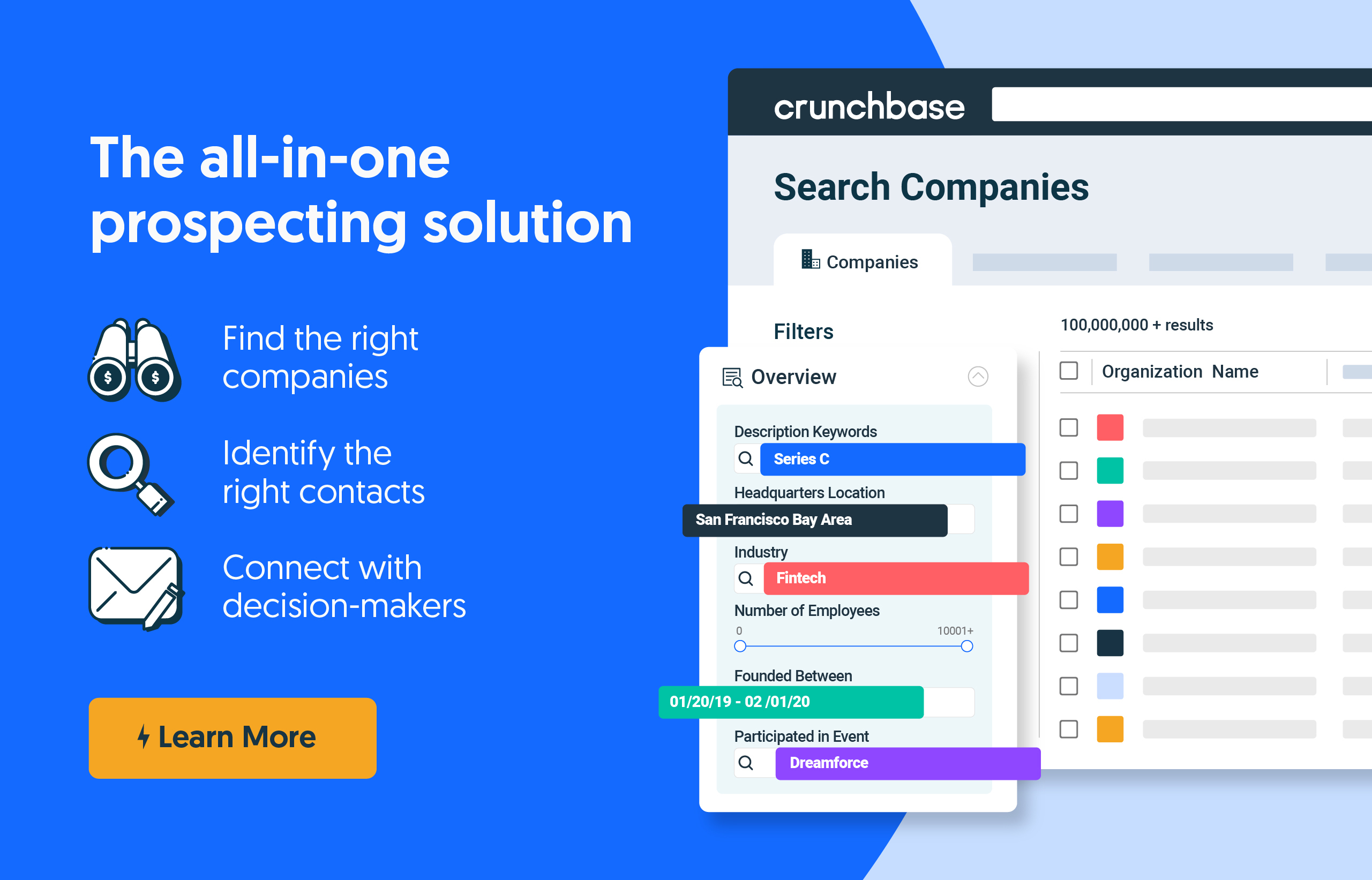So, you’re ready to add to your investment portfolio. Now you’re looking to learn how to find startups to invest in. Here’s what you need to know to find your next investment.
Search less. Invest more.
Find your next investment opportunity with Crunchbase, the leader in private-company data.
Simple Steps to Learn How to Find The Right Startups to Invest In
1. Determine What Kind of Investor You Are
The two main types of investors are angel investors and venture capitalists. An angel investor usually has a high net worth and provides financial backing for small startups or entrepreneurs. A venture capitalist (VC) is an investor that provides financial backing to firms with high growth potential in exchange for an equity stake.
If you prefer to work alone and at the start of a company, being an angel investor might be better for you, while those who work well with others should veer toward being a venture capitalist, as they work with a company. Another difference has to do with how much they invest; angel investors typically invest between $25,000 and $100,000, while a VC’s average investment reaches into the millions.
Identify Your Niche Market
One reason why startups fail is that they are too broad within a market. The same goes for investors. As an investor, it’s important to narrow down your search to a market niche. A niche targets a distinct industry segment in which investors are much more likely to find startups and businesses that solve specific, little-serviced problems.


In essence, finding your niche means choosing to invest in something you love talking about and are intrigued by – and becoming the smartest you possibly can in that respective area. It’s more than diving into a subject. It’s researching the domain expertise, spending time with it, and deciding if you should bet on the products that support it. For example, take these 10 influential investors, who have found their particular niches and interests in the investment space.
10 Notable Investors and Their Investment Niche
- Brian O’Malle
General Partner at Forerunner Ventures – areas of focus include next-generation retailers, marketplaces and enabling commerce software companies
- Esther Dyson
Founder and Partner at Way to Wellville – in the last few years, she has turned her sights towards IT and healthcare
- Alexis Ohanian
General Partner at Initialized Capital – internet and technology entrepreneur and investor that is known for Reddit
- Cyan Banister
Partner at Founders Fund – invests across sectors and stages with interest in augmented reality, fertility, heavily regulated industries and businesses that help people with basic skills find meaningful work
- Peter Thiel
Managing Partner at Founders Fund – technology entrepreneur and investor, known for innovations specifically in banking and startup finance
- Arlan Hamilton
Founder and Managing Partner at Backstage Capital – invests in high-potential founders of color, women, and/or LGBT
- Beth Seidenberg
General Partner at Kleiner Perkins – focuses on life science investing, working with entrepreneurs to develop companies with breakthrough technology for treating patients and improving health
- Geoff Lewis
Founder and Managing Partner at Bedrock Capital – specializes in on-demand services, food tech, mobile commerce and is also leading the first venture capital investment in the legal cannabis space
- Reid Hoffman
Partner at Greylock Partners – areas of focus include sectors like consumer Internet, social gaming, online marketplaces, social networks
- Anthony Davis
Founding Partner at Anslinger Capital – has a passion for technology that specifically solves business problems
Many investors also use this as an opportunity to work with businesses that can make a difference in the world, as it could be a way to translate empathy into effort and action and participate in the ever-changing and progressive climate of diversified founders.
Focus and clarity are essential in owning your niche, so if you’re struggling to decide, start with researching what industries are in the spotlight for growth. Among the many upsides to a well-defined niche, experts argue that businesses targeting a market niche are likely to demand a larger multiple because we live in an age of specialization, making niche businesses much more scalable.
2. How To Find a Startup To Invest in: Analyze the Potential Investment Before The Pitch
The process of investing starts well before an entrepreneur’s pitch even takes place. Investors should analyze their own goals and motives. They should dive into the company’s public documents and details. Lastly, investors should research the trends and competitors in the industry.
How to Perform Investment Research
Whether you’re new to investing or highly experienced, there’s always something to learn about the investment research process. Before diving into each facet of research, consider utilizing a third-party tool that compiles a great deal of information in one place. This makes the process much less arduous and more instinctive.
Qualitative Analysis: Understanding the “Why” Behind Your Investment
After identifying your niche market, it’s time to get to know the companies in the space a little better – on a qualitative and quantitative basis. In the qualitative sense, you’re evaluating the intangible concerns that answer more of the “why” you’re investing. By taking a look at the social and experiential aspects of the company rather than just mathematical ones, you can explore the company’s health on inexact levels before diving into the numbers.
Questions to Ask Before Investing in a Team
The most important qualitative element is the people (the team). More than anything, you’re investing in them. Investors should look for solid management teams equipped with individuals who are rich in experience, skills, and various disciplines. Ask yourself the following questions before investing in a team:
- Is the founder financially invested in some way? They should also have skin in the game.
- Can this team lead the company to a positive exit?
- Is there healthy chemistry and communication between the entrepreneur and yourself (the investor)?
- Does it have a sustainable competitive edge/advantage – in regard to the business model, brand, distribution, operations, patent ownership/intellectual property, unique ability to innovate, etc.? (These are not easily overcome by competitors.)
- Does it solve a major problem or pain point in a big way?
These questions will help shape your “gut feeling” about the company. Once you have satisfactory answers to the questions listed above, you can begin to evaluate the company on a more tangible level.
Quantitative Analysis: Understand the Numbers Around Your Investment
Now, you can look into the quantitative side as you research a company. What does growth look like for this company? The first thing that you should do as a potential investor is to consult the numbers, key company statistics, and financial documents. They help disclose a business’s performance, competitive positioning, and potential risks. A company’s key financial statements include:
- Annual report: summary of what happened in the business for the year
- 10-K filing: includes the balance sheet, income statement, and legal disclosures
- Cash-flow statement: complements the above documents and summarizes the amount of cash and cash equivalents entering and leaving the company


Using these documents, you can then perform an analysis to determine the company’s potential growth and value. While there is no perfect way to predict future earnings, you can make your own estimates by evaluating past figures and profit margins, as well as industry and investment trends. With the help of key financial ratios, such as price-earnings ratio (P/E), which shows how a company is performing compared to others in its industry, or earnings per share (EPS), which shows a company’s profitability on a per-share basis, you can more easily compare companies.
What to Look for When Reviewing Metrics for Companies You Want to Invest in
The best companies to invest in share an extensive understanding of the market and strong metrics. Important metrics include annual recurring revenue (ARR), monthly recurring revenue (MRR), and total addressable market (TAM). A good way to make certain a company is generating a steady stream of ARR is by ensuring the product has a large and continuous demand in a big market.
Ultimately, the bigger the market, the greater the likelihood of making a sale, and the more quickly the business can grow. Growth rates for companies, while they can vary between size, industry, and country, can help forecast revenues.
Series A (early-stage) investors generally don’t get excited unless a startup is growing at 200% or more, while a Series B investors focus on acceleration in growth rates, averaging between 125% to 175%. Series C investors are looking more for continued growth at scale, which is difficult to reach, while Series D or later investors start to see ranks significantly thinning out, often decelerating to 60% to 93% year over year.
How to Research an Industry: Know the Market and its Trends
Immerse yourself in the industry of your niche. Industry knowledge helps investors better parse out which companies are ordinary and which are truly remarkable. Read trade magazines and industry-specific articles, and maybe even compare three or four companies’ annual reports for a decent forecast on the industry. Stay in the know about current news and reports that could have an impact on this industry, and by default, your investment. When learning how to find a startup to invest in, it’s important to have a pulse on a select industry.
Do you feel comfortable investing in this particular industry after all of this? Do you know and understand it the way you should? Even more so, does the company’s management team understand its industry as well as it should?
Find your next investment, faster.
Identify investment opportunities with Crunchbase.
3. How To Find a Startup To Invest In: What to Look for in an Investment Pitch
An investment pitch is as much a market opportunity for you as it is for the entrepreneur. It’s a chance for you, as an investor, to take part in a potentially prosperous venture, and it’s an opportunity for an entrepreneur to lay down a market strategy and projections for a product or service he or she is passionate about. This is a moment of truth for the startup, as you should be looking for several things throughout a pitch that will determine a “yes” or “no” to this investment.
Have They Set Realistic Expectations?
Tan Kabra, Founder and CEO of LaunchByte, believes that the ability to express realistic expectations for the company is a sign of a solid entrepreneur. While it’s possible to revolutionize an entire market, it’s best to focus on how the problem that is specific to the market is solved. The rest will follow.
Do They Give Exact Amounts?
Entrepreneurs should give you, the potential investor, exact amounts for their desired investments. They should also project use of these funds in scaling the business. Additionally, they should review what they expect their ROI to be, how many expenses they anticipate, details on the targeted audience, and time frames for potential future investments.
Does it Solve a Problem?
Founders pitching you should display a strong understanding of the pain points their product/service are addressing. Do you sense their grasp of the problem and how their solution will solve that problem?
Are They Well-Informed on the Industry Climate and Competitors?
Ideally, the startup founder will be highly knowledgeable in the product’s field, will know the company’s toughest competitors, and be well-informed of the current industry climate and trends. You’ll be able to tell because you will be well-informed on the industry climate and competitors.
Do They Have a Prototype?
When determining how to find a startup to invest in, most investors will go straight to the product. A product prototype is crucial to your understanding of what customers will see and experience. It allows you to connect an idea to the real thing. If there’s nothing to see or experience, it’s all theory – and theory isn’t easy to bet on.
Do You Sense Passion?
The story behind the product is important. Where did it start? Why? Entrepreneurs need to live and breathe their company, product, and vision. This shows commitment and a drive to make this potentially shared dream come true. Stephanie Palmeri, a partner at Uncork Capital, believes the entrepreneur’s personal story is powerful in communicating experience, motivation, and perseverance to accomplish these business goals.
Is the Investor-Entrepreneur Chemistry Good?
You are gaining a business partner for however long this venture lasts. It’s important that you sense healthy chemistry between yourself and the entrepreneur. Fair and honest communication is very important in building the company.
Do They Have a Map of Projections (Costs, Pricing, Margins)?
A thoughtful presentation of revenue and cost projections should increase the entrepreneur’s credibility in your eyes as an investor. Brian Cohen, Chairman of the New York Angels, believes the entrepreneur should have a solid financial plan with market trends in mind. Two things to look for: you want to see the gross margins in the 50 percent range or higher, and the venture should also have a large enough total addressable market (TAM) – the market should be able to generate $1 billion or more in revenue.
Have They Set Deadlines?
Tangible deadlines and timelines not only show that the entrepreneur is serious about getting the necessary funding and being organized but that he or she is committed to this venture for the long-term.
Do They Have a Customized Marketing Strategy and Sales Plans?
There is more to the business than the product itself and gross margins. What about plans for distribution? Partnerships? Sales channels? Make sure they touch on these, as well as the use of social media and modern and conventional marketing in amplifying the rollout of the business.
4. How to Decide to Invest and Find the Right Startup To Invest In
You’ve done your research and listened to the pitch. Now, how do you know if it’s time to financially take the plunge? It comes down to a few details that will ultimately help you predict (as much as possible) how profitable this decision will be for you.
How to Structure an Investment Deal
Here’s the truth: If a deal isn’t favorable for both sides, it’s not really a good deal. It’s about creating a long-term business relationship that benefits both parties. You want the right person to lead the negotiation, someone with plenty of experience in deal leads. And, you want an experienced lawyer to assist in discussing and negotiating what will end up on the term sheet.
Calculate Your Return on Investment
Without determining the return on your potential investment, what would be the point of the investment at all? ROI is a key financial metric of probability you can use to measure the return or gain from an investment. This can be done to evaluate one investment or compare several.
While it’s very difficult to predict which investments will produce the best returns, there is a way to estimate. The ROI formula isn’t too complicated: ROI = (Net Profit/Cost of Investment) x 100. Usually expressed as a percentage, ROI is also a very flexible metric that can be manipulated for different uses. However, it does not take time into account. Therefore, a certain percentage of return over one year may be less ideal if it were the same result over two years.


For a venture capitalist, a minimum respectable return is between 20 and 25 percent per year. Because it is difficult to perfectly predict, it’s very important to track and keep a diversified portfolio with high-quality companies.
Plan Your Investment Exit Strategy
A big part of learning how to find the right startup to invest in is understanding the exit strategy. Knowing ahead of time the tentative business exit strategy – how the founder(s)/owner(s)s intends to sell the company – could give you an idea of how far ahead the entrepreneur has thought. It will also give you an idea of how much control or involvement they plan to have after choosing one of the main exit strategies: initial public offerings (IPO), strategic acquisitions, or management buyouts (MBO).
As for you and your ownership, the median and average level of venture capitalist ownership at their exit in our Crunchbase assessment was 53 percent and 50 percent, respectively. In other words, by the time of exit, you will likely own half of the business. Therefore, it’s just as important to sell your portion of a company as timely as it was to buy into it. So, when do you sell?
When Do You Sell Your Company Stock?
Maybe you recently underwent a life change, such as a marriage, divorce, or birth. Take this time to adjust your portfolio and realign it to your investing goals. Free up some capital to make a big life purchase or cover a medical bill. While the tax side of things is unpleasant, don’t let it keep you away from selling. Realize your losses to offset your gains.
Every business has a not-so-good quarter. Don’t let poor performance over one quarter or even one rough year be the reason you sell. There are plenty of outside factors that could have caused a down year. Quite frankly, by the time you hear about it, you’re reacting to something that happened a while ago. By now, certain fixes should be underway for the new year. Just steer clear of reacting. Be strategic.
Managing an Investment Portfolio
Managing, analyzing, and keeping track of your investments can be tedious and even daunting, but it’s necessary. With the help of advanced portfolio tracking software such as Crunchbase Pro, staying organized and watchful of your portfolio companies and follow-on investments becomes more streamlined. Monitor your companies’ successes through our management platform and find other great companies to invest in throughout the process and help you determine how to find the right startup to invest in.








